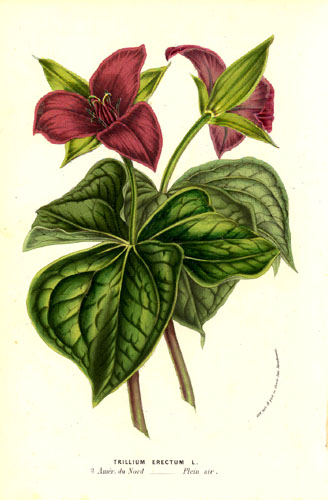
Trillium erectum (L) and Trillium pendulum (Willd.)
 Synonyms: birth root, wake robin, nodding
wakerobin, Indian shamrock, lamb's quarters, Indian balm, ground lily, cough
root, Jew's harp plant, milk ipecac, Pariswort, rattlesnake root, snakebite, three-leaved nightshade,
trillium
Synonyms: birth root, wake robin, nodding
wakerobin, Indian shamrock, lamb's quarters, Indian balm, ground lily, cough
root, Jew's harp plant, milk ipecac, Pariswort, rattlesnake root, snakebite, three-leaved nightshade,
trillium
Order: Liliaceae
Description: T. pendulum is an herbaceous perennial which grows in rich soils and shady woods of the central and western United States and grows to a height of 40cm. The simple stem arises from an oblong, tuberous rootstock and bears at the top a whorl of three round-ovate acuminate leaves. In May and June a single yellow-white to reddish-white flower appears above the leaves. T. erectum is a stout erect perennial herb with a simple stem bearing a whorl of three broad rhombic pointed leaves and terminating in a large terminal flower with six petals, purple, pale green or pale brown. It grows in rich woodland in the central and western states of the USA.
Parts used: rhizome and roots
Collection: late summer or early autumn
Constituents: Saponin glycosides such as trillin and trillarin; tannins, fixed oil. Little work has been carried out on T.erectum or T.pendulum but the related species T.kamtschaticum and T.tschonoskii, used in Oriental medicine, contain steroidal saponins including diosgenin.
Actions: Astringent, antihaemorrhagic (with particular action on the female reproductive system), mild expectorant, uterine tonic, antiseptic, diaphoretic, emmenagogue
Indications: metrorrhagia, menorrhagia, haematuria, haemoptysis, as a douche for leucorrhoea and as a poultice or ointment for indolent ulcers.
Therapeutics and Pharmacology: Trillium contains a natural precursor of the female sex hormones, which the body may utilise or not, thereby having a normalising effect. It is used for menorrhagia and metrorrhagia and against complications arising during labour, including post-partum haemorrhage. It is considered to be a specific for excessive blood loss associated with menopausal changes, and is a palliative remedy for blood loss from the urinary tract. It is also used to treat coughs, bronchial problems and pulmonary haemorrhage, as well as gastro-intestinal bleeding, diarrhoea and dysentery. The underlying causes of any blood loss should be treated with the appropriate remedies.
Trillium may be administered as a douche for leucorrhoea or as a poultice or ointment for varicose and other ulcers. As a poultice or salve it is an effective application for insect bites and stings.
Combinations: May be combined with Ulmus and a small amount of Lobelia seed as a poultice for boils and ulcers, and with Geranium in menorrhagia.
Preparation and Dosage: (thrice daily)
Regulatory status GSL
Dried root and rhizome: 0.5-2g or as decoction in water or milk
Liquid extract: 1:1 in 25% alcohol, 0.5-2ml
Tincture: 1:5 in 40% alcohol, 1-4ml
Additional Comments: Native Americans used this plant as an aid to parturition, hence the name Birthroot. It is a popular remedy within Shaker communities in the United States. Most of the genus Trillium have medicinal properties.
Bibliography
BHMA 1983 British Herbal Pharmacopoeia, BHMA, Bournemouth.
Grieve, M. 1931 A Modern Herbal, (ed. C.F. Leyel 1985), London.
Hoffmann, D. 1990 The New Holistic Herbal, Second Edition, Element, Shaftesbury.
Lust, J. 1990 The Herb Book, Bantam, London.
Mabey, R. (ed.) 1991 The Complete New Herbal, Penguin, London.
Mills, S.Y. 1993 The A-Z of Modern Herbalism, Diamond Books, London.
Wren, R.C. 1988 Potter's New Cyclopaedia of Botanical Drugs and Preparations, C.W.Daniel, Saffron Walden.










